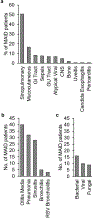The immunologic features of patients with early-onset and polyautoimmunity
- PMID: 31838215
- PMCID: PMC7050734
- DOI: 10.1016/j.clim.2019.108326
The immunologic features of patients with early-onset and polyautoimmunity
Abstract
Inflammatory conditions are increasingly described in patients with primary immunodeficiencies; however, little is known about the prevalence of immune defects in patients who present first with autoimmunity. We describe the immunologic features of children with early-onset/polyautoimmunity followed in the Multiple Autoimmunity and Immunodeficiency (MAID) Clinic, where patients are co-managed by rheumatologists and immunologists. The most common autoimmune manifestations were cytopenias, lymphoproliferation, and colitis. Recurrent infections were noted in 65% of patients. Abnormalities in lymphocyte subsets and immunoglobulins were common. A pathogenic variant was identified in 19% of patients, and 2 novel inherited disorders were discovered. Additionally, 42% of patients had treatment changes implemented in the MAID clinic. By evaluating this unique cohort of patients, we report on the immunologic underpinning of early-onset/polyautoimmunity. The high rate of genetic diagnoses and treatment interventions in this population highlights the value of collaboration between rheumatologists and immunologists in the care of these complex patients.
Keywords: Autoimmunity; Immune dysregulation; Primary immunodeficiency.
Copyright © 2019. Published by Elsevier Inc.
Conflict of interest statement
Declaration of Competing Interest None.
Figures






References
-
- Grimbacher B, Warnatz K, Yong PFK, Korganow AS, Peter HH. The crossroads of autoimmunity and immunodeficiency: Lessons from polygenic traits and monogenic defects. J Allergy Clin Immunol. 2016. January;137(1):3–17. - PubMed
-
- Maggadottir SM, Sullivan KE. The intersection of immune deficiency and autoimmunity. Curr Opin Rheumatol. 2014. September;26(5):570–8. - PubMed
-
- Fischer A, Provot J, Jais JP, Alcais A, Mahlaoui N, members of the CFPIDsg. Autoimmune and inflammatory manifestations occur frequently in patients with primary immunodeficiencies. The Journal of allergy and clinical immunology. 2017. November;140(5):1388–93 e8. - PubMed
Publication types
MeSH terms
Grants and funding
LinkOut - more resources
Full Text Sources

